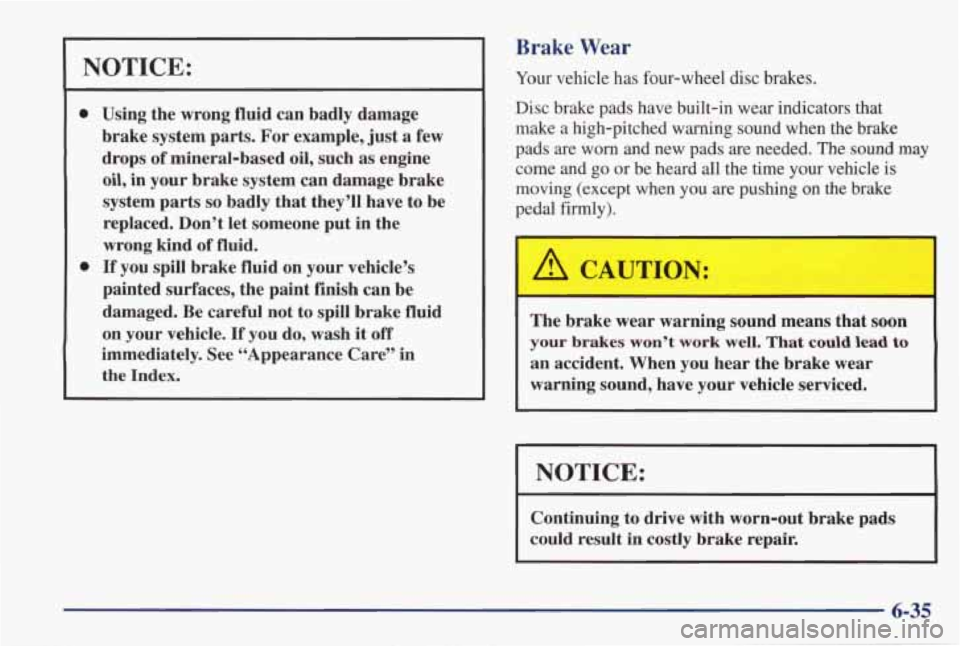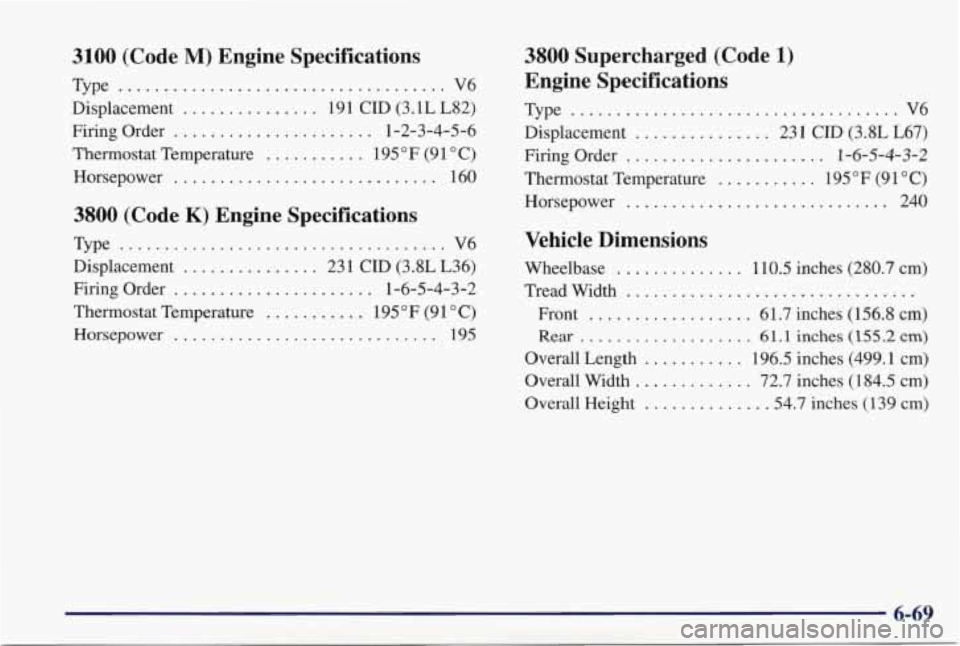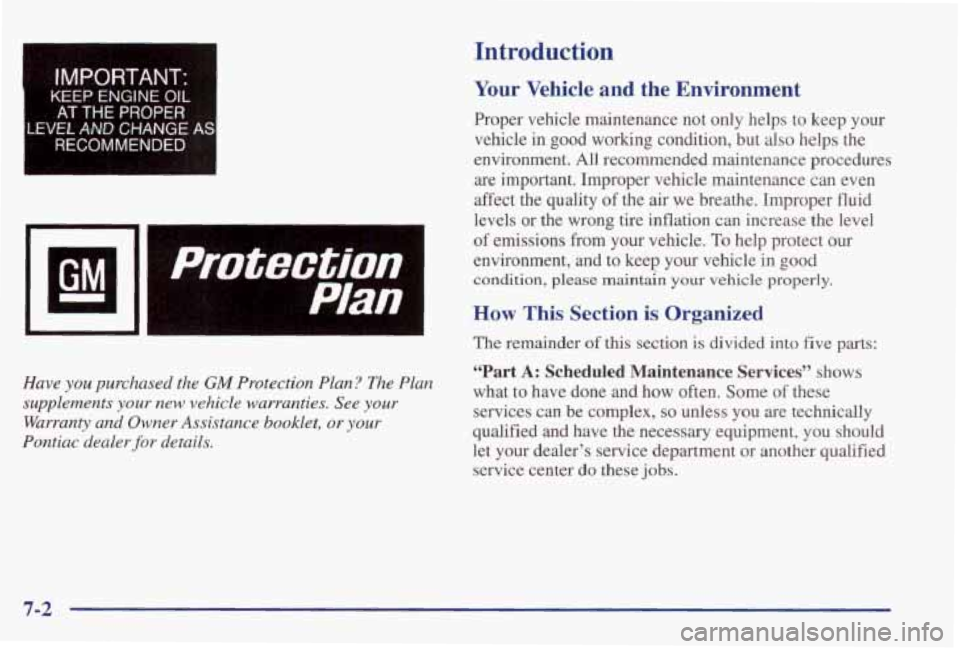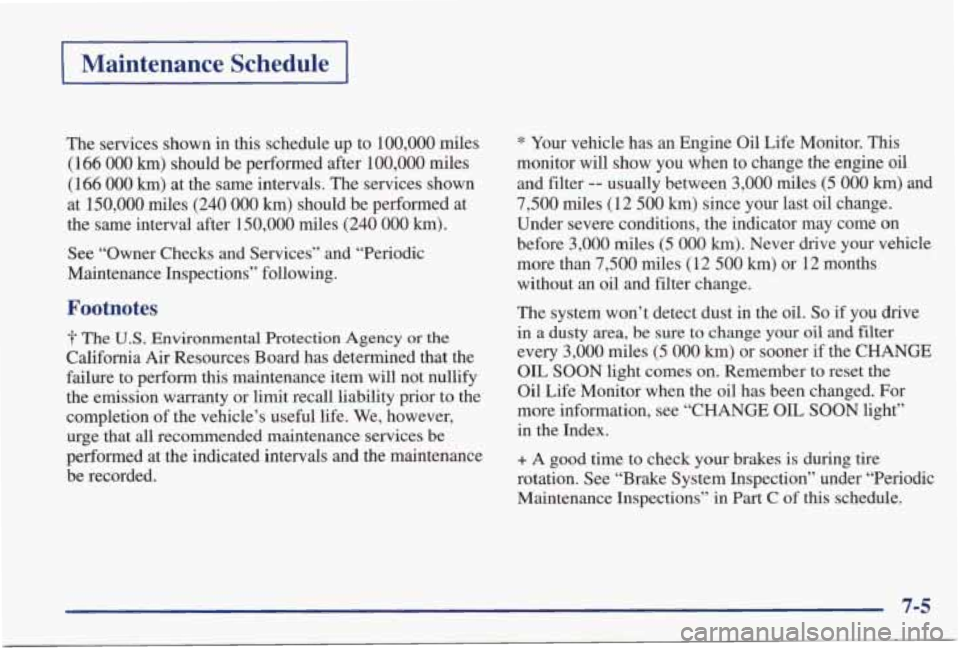Page 310 of 402

NOTICE:
0
0
Using the wrong fluid can badly damage
brake system parts. For example, just a few
drops
of mineral-based oil, such as engine
oil, in your brake system can damage brake
system parts
so badly that they’ll have to be
replaced. Don’t let someone put in the
wrong kind
of fluid.
If you spill brake fluid on your vehicle’s
painted surfaces, the paint finish can be
damaged. Be careful not to spill brake fluid
on your vehicle.
If you do, wash it off
immediately. See “Appearance Care’’ in
the Index.
Brake Wear
Your vehicle has four-wheel disc brakes.
Disc brake pads have built-in wear indicators that
make
a high-pitched warning sound when the brake
pads are worn and new pads are needed. The
sound may
come and go or be heard all the time your vehicle is
moving (except when you are pushing on the brake
pedal firmly).
The brake wear warning sound means that soon
your brakes won’t work well. That could lead to
an accident. When you hear the brake wear
warning sound, have your vehicle serviced.
I NOTICE:
Continuing to drive with worn-out brake pads
could result in costly brake repair.
6-35
Page 336 of 402
Vehicle Identification Number (VIN) Engine Identification
The 8th character in your VIN is the engine code. This
code will help
you identify your engine, specifications
and replacement parts.
Service Parts Identification Label
ENGINE/!& f ASSEMBLY You’ll find this label on the underside of your trunk lid. \
CODE MODEL YEAR PLANT It’s very helpful if you ever need to order parts. On this
label is:
This is the legal identifier for your vehicle. It appears on
a plate in the front corner of the instrument panel, on the
driver’s side. You can see it if you look through the
windshield from outside your vehicle. The VIN also
appears
on the Vehicle Certification and Service Parts
labels and the certificates of title and registration.
your VIN,
the model designation,
0 paint information and
a list of all production options and special
equipment.
Be sure that this label is not removed from the vehicle.
6-61
Page 340 of 402
AUWCNSL CD CHG
ECM
CRUISE
UP-IGN
SIR
TURN
ABS
BTSI
PWR DROP HVAC CTRL
DIC/HVAC
DRL Auxiliary Power, Overhead Console
CD Changer
Underhood Electrical Center
-- Passenger’s Side
ECM
Cruise Control
ChimeNall Module, Cluster, Trip
Computer, Head-Up Display,
Brake-Transaxle Shift Interlock
Supplemental Inflatable Restraint
Turn Signal
(Air Bag)
Anti-Lock Brakes
PRNDL, Brake-Transaxle Shift Interlock
Power Drop Ignition
Blower Control, HVAC
Rear Defog, HVAC, Driver
Information Center, Daytime
Running Lamps, Heated Seats
Canister
Vent Solenoid
Daytime Running Lamps Some fuses are in a fuse block on the passenger’s side
of
the engine compartment. Pull
off the cover labeled
FUSES
to expose the fuses.
6-65
Page 343 of 402

Replacement Bulbs
Exterior Lamps ............... Bulb Number
Back-up ............................... 3 156
Front Parking/Turn Signal
.............. .3357NA
Center High-Mounted Stop
................ 1141
Headlamps HighBeam
........................... 9005
Low Beam ........................... 9006
Front Sidemarker
......................... 194
Rear Sidemarker ......................... 194
Stop/Tail/Turn Signal ..................... 3057
Capacities and Specifications
Please refer to “Recommended Fluids and Lubricants”
in the Index for more information.
Automatic Transaxle with Overdrive
Pan Removal and Replacement ..... 8 quarts (7.5 L)
After Complete Overhaul ......... 10 quarts (9.5 L)
When drainingheplacing converter or auxiliary coolel;
more fluid
my be needed.
Cooling System Including Reservoir
3100 (CodeM) ............... 11 quarts (10.42 L)
3800 (Code K) .............. 12.3 quarts (11.65 L)
3800 Supercharged (Code 1) ... 12.3 quarts (11.65 L)
Refrigerant (R-l34a),
Engine Crankcase (Oil Change with Filter Change)
Air Conditioning*
............ 1.9 lbs. (0.85 kg)
3100 (Code M)
................ 4.5 quarts (4.2 L)
3800 (Code K) ................ 4.5 quarts (4.2 L)
Fuel Tank .................... 18 gallons (68 L)
3800 Supercharged (Code 1) ..... 4.5 quarts (4.2 L)
*See “Air Conditioning Refrigerants ” later in this section.
Note: All capacities are approximate. When adding, be
sure to fill the appropriate level, as recommended
in this
manual. Recheck fluid level after filling.
See “Recommended Fluids and Lubricants” in
the Index
for more information.
6-68
Page 344 of 402

3100 (Code M) Engine Specifications
Type .................................... V6
Displacement
....... . . 191 CID (3.1LL82)
Firing Order
...................... 1-2-3-4-5-6
Thermostat Temperature
........... 195 OF (9 1 O C)
Horsepower
................. ........ 160
3800 (Code K) Engine Specifications
Type .................................... V6
Displacement
............... 231 CID (3.8L L36)
Firing Order
...................... 1-6-5-4-3-2
Thermostat Temperature
........... 195 OF (9 1 O C)
Horsepower ............................. 195
3800 Supercharged (Code 1)
Engine Specifications
Type .................................. V6
Displacement
. . ......... 23 1 CID (3.8L L67)
Firing Order
.................... 1-6-5-4-3-2
Thermostat Temperature
. . ..... 195"F(9l0C)
Horsepower
......... ........... 240
Vehicle Dimensions
Wheelbase .............. 110.5 inches (280.7 cm)
Tread Width
................................
Front .................. 61.7 inches (156.8 cm)
Rear ................... 61.1 inches (155.2 cm)
Overall Length ........... 196.5 inches (499.1 cm)
Overall Height
............ 54.7 inches (1 39 cm)
Overall Width
.... ..... 72.7 inches (1 84.5 cm)
Page 345 of 402
Normal Maintenance
Replacement Parts
......... A1208C
Air Cleaner Filter
Battery
All Engines ..............
3100 (Code M) ......... ........ 600CCA
3800
(Code K) ...................... 690 CCA
3800 Supercharged (Code 1) ........... 770 CCA
All Engines ................. AC PF47
All Engines ...................... CV892C
Engine Oil Filter
PCV
Valve
Radiator Cap
All Engines ... .............. AC RC27
Spark Plugs
3100 (Code M) . . ......... AC Vpe 41-940
Gap: 0.060 inches (1.52 cm)
3800 (Code K) ................ AC Type 41-921
Gap: 0.060 inches (1.52 cm)
3800 Supercharged (Code 1) . . AC Qpe 41-921 or
NGK 5pe PTR4B- 15
Gap: 0.060 inches (1.52 cm)
Wiper Blades
vpe ................................. Hook
Length ................... .20 inches (50.8 cm) -
Air Conditioning Refrigerants
Not all air conditioning refrigerants are the same. If
the air conditioning system in your vehicle needs
refrigerant, be
sure the proper refrigerant is used. If
you’re not sure, ask your dealer.
6-70
Page 347 of 402

I
tMPORTANT-
KEEP ENGINE OIL
AT THE PROPER
LEVEL AND CHANGE AS
RECOMMENDED I
I
Wl
I Protection 1
Plan
Have you purchased the GM Protection Plan? The Plan
supplements
your new vehicle warranties. See your
Warranty and Owner Assistance booklet, or your
Pontiac dealer for details.
Introduction
Your Vehicle and the Environment
Proper vehicle maintenance not only helps to keep your
vehicle in good working condition, but also helps the
environment.
All recommended maintenance procedures
are important. Improper vehicle maintenance can even
affect
the quality of the air we breathe. Improper fluid
levels or the wrong tire inflation
can increase the level
of emissions from your vehicle.
To help protect our
environment, and
to keep your vehicle in good
condition, please maindn your vehicle properly.
How This Section is Organized
The remainder of this section is divided into five parts:
“Part A: Scheduled Maintenance Services” shows
what to have done and how often. Some
of these
services
can be complex, so unless you are technically
qualified
and have the necessary equipment, you should
let your dealer’s service department
or another qualified
service center
do these jobs.
7-2
Page 350 of 402

Maintenance Schedule
The services shown in this schedule up to 100,000 miles
(166
OOO km) should be performed after 100,000 miles
(166
000 km) at the same intervals. The services shown
at
150,000 miles (240 000 km) should be performed at
the same interval after 150,000 miles
(240 000 km).
See “Owner Checks and Services” and “Periodic
Maintenance Inspections” following.
Footnotes
? The US. Environmental Protection Agency or the
California Air Resources Board has determined that the
failure to perform
this maintenance item will not nullify
the emission warranty or limit recall liability prior
to the
completion
of the vehicle’s useful life. We, however,
urge that
all recommended maintenance services be
performed at the indicated intervals and the maintenance be recorded.
* Your vehicle has an Engine Oil Life Monitor. This
monitor will show you when to change the engine oil
and filter
-- usually between 3,000 miles (5 OOO km) and
7,500 miles (12 500 km) since your last oil change.
Under severe conditions, the indicator may come
on
before 3,000 miles (5 000 km). Never drive your vehicle
more than
7,500 miles (12 500 km) or 12 months
without
an oil and filter change.
The system won’t detect dust
in the oil. So if you drive
in
a dusty area, be sure to change your oil and filter
every 3,000 miles (5 000 km) or sooner if the CHANGE
OIL SOON light comes on. Remember to reset the
Oil Life Monitor when the oil has been changed. For
more information, see “CHANGE
OIL SOON light”
in the Index.
+ A good time to check your brakes is during tire
rotation. See “Brake System Inspection” under “Periodic
Maintenance Inspections”
in Part C of this schedule.